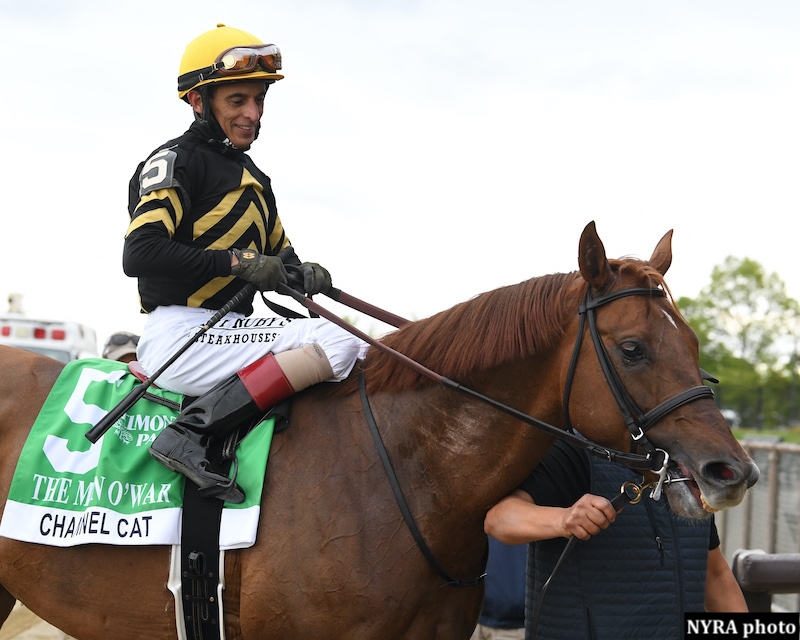The following appeared in The Paulick Report May 13 and was written by Frank Mitchell. English Channel, winner of $5.3 million in purse money, started his illustrious stakes career with wins in the 2005 Colonial Turf Cup and Grade 3 Virginia Derby at Colonial Downs.
Is there a less-appreciated upper-tier sire in the country than English Channel?
Channel Cat’s victory in the Grade 1 Man o’ War Stakes was a reminder of the excellence that the stallion imparts to his offspring and that English Channel showed emphatically during his own racing career.
The 19-year-old son of Smart Strike and the Theatrical mare Belva proved himself a hickory racer, winning 13 of 23 starts over four seasons and $5.3 million. At the races, English Channel began his career the right way: winning his debut at 2 at Saratoga.
The horse then proceeded to win four of his first five starts at 3, including the Grade 3 Virginia Derby, and he also placed second in a pair of G1 races, the Secretariat at Arlington and the Joe Hirsch Turf Classic Invitational at Belmont.
English Channel returned to the races at 4 to win a trio of G1 stakes: the Turf Classic at Churchill Downs, the Joe Hirsch Turf Classic at Belmont, and the United Nations at Monmouth Park. Then the horse returned at 5 and did the same thing. And this time, a trio of G1s, the Turf Classic at Belmont and the United Nations, plus the Breeders’ Cup Turf run at Monmouth Park, brought English Channel the Eclipse Award as champion male turf horse.
And a turn at stud.
English Channel’s sire, Smart Strike, could not have been hotter at the time. He was the leading sire in North America, due not only to English Channel but also to Curlin, who was elected champion 3-year-old colt and Horse of the Year in 2007 after G1 victories in the Preakness, Jockey Club Gold Cup, and Breeders’ Cup Classic.
The cachet of a stallion like Smart Strike – himself a son of the great Mr. Prospector – who could sire such good horses brought considerable attention to his sons and then sent them to stud with lordly expectations of success.
Yet, aside from their sire, high racing class, and chestnut coats, two horses could hardly be more different than English Channel and Curlin.
The latter is a brawny beast who left some breeders wondering whether he might not be too massive a specimen to breed on successfully. Time and the proof of elite racing class have disproven those concerns.
The exact opposite concern was held for English Channel, who came to stud looking so racy, lean, and elegant that some breeders wondered if he would produce enough muscle and mass in his stock to make them high-class racehorses.
Time and the test of the racecourse have proven that English Channel can sire those top horses, with 30 graded stakes winners to date, which is more than half of all his 58 stakes winners. They come in a range of sizes, colors, and shapes that has tended to bewilder the commercial market, which values consistency very nearly as much as quality.
A stallion of similar character is the broodmare sire of Channel Cat: Kitten’s Joy. A champion turf racer like English Channel, Kitten’s Joy throws a wild array of physical types, from the lean-bodied sort who remind us of whippets to the hulking powerhouses similar to himself.
Yet both Kitten’s Joy and English Channel are very good sires, especially of turf horses, and in part that is because a turf horse has to have some level of pace to succeed. It is a great gift if the racer possesses a first-rate change of pace like these two champion turf performers, but the ability to get up to the lead and tough it out to the wire is evidence of a grand racing character and a hardy constitution.
Channel Cat possesses these in spades. He relied upon his strengths so effectively that he made the Man o’ War a considerable test of stamina (starting with an opening quarter mile in :22.69) and then refused to be swamped for speed in the final three furlongs, which he ran in :35.85.
In addition to his own genetic contribution to the greatest game, English Channel has succeeded because breeders, especially the owner of Calumet Farm, have believed in the stallion and have supported him with quality mares. For a stallion who does not often get the “sales type” of yearling, this is an essential support system, and the sport is all the richer for it.
Frank Mitchell is author of Racehorse Breeding Theories, as well as the book Great Breeders and Their Methods: The Hancocks. In addition to writing the column “Sires and Dams” in Daily Racing Form for nearly 15 years, he has contributed articles to Thoroughbred Daily News, Thoroughbred Times, Thoroughbred Record, International Thoroughbred, and other major publications. In addition, Frank is chief of biomechanics for DataTrack International and is a hands-on caretaker of his own broodmares and foals in Central Kentucky. Check out his Bloodstock in the Bluegrass blog.


